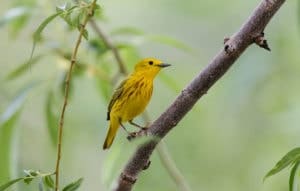Yellow Warbler
Peak numbers of Yellow Warblers will arrive through mid to late May. Watch for these charming insectivores as they pursue their prey through the canopy of deciduous trees. Early bird surveys in the 20th century reported Yellow Warblers to be common in urban areas with large trees; numbers declined by the middle of the century. Yellow Warblers in Oregon come from wintering grounds in Colombia and Venezuela, and eventually settle into breeding grounds in riparian areas throughout the state.

Swainson’s Thrush
From the dark recesses of riparian thickets, the ethereal upward-spiraling song of the Swainson’s Thrush is a familiar sound of summer. Breeding birds west of the Cascades winter mostly in west Mexico but also in the highlands of Central America. Watch for these speckle-breasted thrushes as migrants begin arriving in early May, and peak in mid to late May. With a little luck, they might visit your backyard water feature during migration!

Western Wood-pewee
The silhouette of a flycatcher at the end of dead branches or at the top of a tree is likely to be a Western Wood-Pewee. These long-winged and upright-postured birds are found sallying for insects in open deciduous woodland and mixed forest edges, and their nasally “pee-er” song can be heard throughout the day. Breeding Western Wood-Pewees in western Oregon arrive from populations that migrate from Colombia. Good numbers of this energetic flycatcher will continue passing through from mid to late May.

Olive-sided Flycatcher
The loud “quick-three-beers” song and “pip-pip-pip” call of the Olive-sided Flycatcher can carry quite a distance as it vocalizes from the tops of trees and snags. They are found in open coniferous forest with many snags, often at the edge of meadows and burned forest. Olive-sided Flycatchers likely rely on snags and early successional post-fire habitat for breeding success. They arrive from The Andean highlands and foothills (Colombia to Bolivia), over the last few days of April, but peak numbers come through our area in mid-May.

Cedar Waxwing
Numbers of Cedar Waxwings are erratic and variable from year-to-year. However each spring there seems to be an increase of Cedar Waxwing by May. The flocks that arrive can be seen making frequent sallies for insects and taking advantage of early ripening fruits of the Osoberry (Oemleria cerasiformis).




